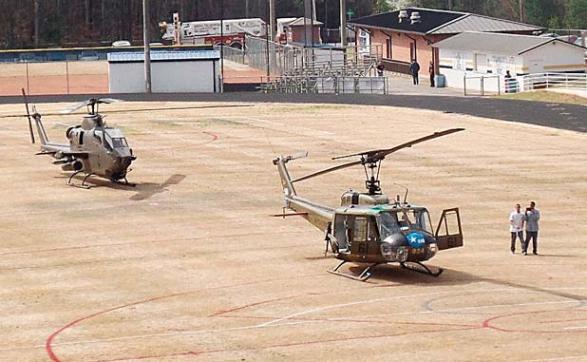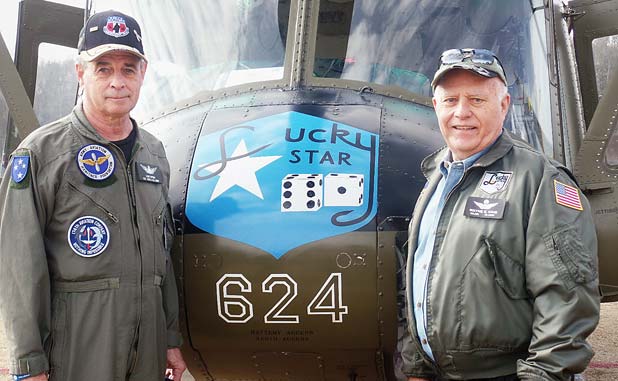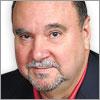How do you know when you are rubbing shoulders with someone who has left footprints in history? Well, sometimes you don’t. I’ll tell you about two men here in Peachtree City who left footprints serving their country when it was not easy, and how you can help keep their history alive.
Cliff Stern and his wife Paula live in the Interlochen development. A retired U.S. Army lieutenant colonel, Cliff is now president of the Army Aviation Heritage Foundation (AAHF), a unique non-profit volunteer outfit of veterans and civilians with a hangar at Tara Field near the racetrack in Hampton.
AAHF keeps a number of Vietnam War aircraft maintained in tip-top flying condition. You might instinctively worry about helicopters over 40 years old, but the intensity of AAHF maintenance puts these birds in far better condition today than they ever were when we flew them into combat in Vietnam.
The AAHF flies in airshows and provides static displays and rides all over the country. Last week they flew to Nashville to display at the Army Aviation Association of America convention. They have done numerous flybys at the Vietnam Memorial in Washington, D.C., and at other venues on Memorial Day and other events.
Two weeks ago Cliff’s group flew a Huey and a Cobra into the soccer field at Newnan High School, where a number of us who flew in the Vietnam War gathered around the aircraft to talk to hundreds of students interested in the helicopters and our experience.
Why is Cliff so passionate about connecting veterans and civilians by capturing attention with helicopters that flew in the war? Well, he was a Huey helicopter pilot in that war, flying combat assault lift missions as a platoon leader with the 174th Assault Helicopter Company, flying loads of ground troops into and out of landing zones.
Cliff’s son, John, owner of John’s Golf Carts here in Peachtree City, so admires what his father did decades ago that he built a beautiful golf cart for him with silk-screened images from the war.
On his first day with his unit in Vietnam, Cliff had his customary check ride in the morning, and that very afternoon, because they were one pilot short, this new guy flew an emergency extraction mission for a Special Forces team under attack by enemy forces. He hoped things wouldn’t get worse than that initial excitement, but they did.
Near the end of the war in February of 1971, the massive Lam Son 719 operation had been planned for five to seven divisions to cross the border into Laos to cut the enemy’s Ho Chi Minh Trail where they had operated unchallenged for years. In execution, only three divisions were committed against an enemy dug in very deep.
The staging area was Khe Sanh where they launched on Feb. 8. The huge lift flight of about 100 Hueys were loaded with South Vietnamese grunts because most American ground troops had been withdrawn from Vietnam and by order of the 1970 Cooper-Church Amendment in Congress, no American troops were permitted to put boots on the ground in Laos. Americans provided support in logistics, artillery, air transport and air cover.
When Cliff flew into LZ Hotel that first day, he was in front only because the two aircraft that had been in front of him had already been shot down. He had Bob Gentry as his wingman since they had worked together every day and knew each other’s moves and signals.
When Cliff took off after dropping his ground troops, he spotted an enemy anti-aircraft team setting up and just seconds later they shot Bob dead, though his chicken plate (chest protector). He had celebrated his 22nd birthday two days prior. Bob’s co-pilot, Steve Burch, quickly took the controls to recover the aircraft. Steve died in a fiery crash a few weeks later.
On that same day, Cliff flew fresh loads of troops back into that same LZ five more times, and at the end of the day he picked up eight wounded South Vietnamese soldiers and delivered them to a hospital. Cliff received the Distinguished Flying Cross for heroism that first day of Lam Son 719.
Joe Galloway, the most respected correspondent of the war, covered the operation and says a pro-Hanoi spy in Saigon leaked the plan to our enemy a month in advance, and 60,000 battle-hardened NVA troops were waiting to fight. The bad guys had 19 anti-aircraft battalions in the area including the feared .51 caliber plus larger 23mm, 37mm and 57mm guns guided by radar. Cliff saw more than a half-dozen helicopters shot out of the air by big guns, including Cobras hit broadside and broken apart mid-air.
The operation proceeded for more than two weeks, but with our Vietnamese allies losing the ground fight against a much tougher enemy and weather hampering air support, a withdrawal was initiated which Cliff summarizes as just awful. When he flew in to pick up South Vietnamese grunts, they panicked and rushed to overload the helicopter with too many so the crew chief and gunner had to throw troops off. Even then some held onto the skids in desperation to get out until they fell to their injury or death from altitude. Cliff said they had to do something to get the grunts out without overloading and causing a fatal crash, so they greased the skids.
When the operation was over, out of the 33 Hueys Cliff’s unit flew into Laos, only five remained. These are memories that do not fade.
U.S. Army Major (Ret.) Wayne King also left footprints in history flying Hueys in the Vietnam War. Wayne lives just down the road from Cliff in the Highlands development with his wife, Cookie.

Like Cliff, he flew lift missions in the Vietnam War but with the 61st Assault Helicopter Company based at LZ English. Since 6+1 is a key roll of the dice in the game of craps, the 61st takeoff pad was known as the Crap Table and the Huey lift platoons were called Lucky stars.
As a helicopter gunship pilot myself, I often watched lift pilots taking troops into a hot LZ, clustered in a tight formation to fit into a small clearing with gunfire zipping through the thin-skinned aircraft, and I asked Wayne to explain for students the pucker factor of taking fire in that setting. He told me they should think about it this way.
With a load of armed grunts in the back, the ride was usually at the treetops to evade enemy fire, dipping and rolling with the terrain and the grunts with their feet hanging over the side sometimes yelled their delight at the ride.
When the LZ was not far away, the pilots climbed to tighten up in formation with just one rotor blade of separation since they needed to touch down and take off as one to minimize exposure to enemy fire, and room in the LZ was often tight.
They stepped up toward the back, keeping the next rotor to the front lower and level with the horizon, jockeying to stay in position, trying to prevent the dangerous stretch and compression of a slinky, and keeping the right rear skid strut visually lined up with the left front strut on the aircraft to the front left to stay in position, even in a slow turn, listening intently to radio traffic announcing the marker rounds from artillery indicating their prep fire was complete, then gunships like mine were alongside firing rockets, trying to nail the enemy or at least keep their heads down while our grunts got on the ground, sometimes scaring the hell out of the lift pilot if it was close, listening for other pilots announcing, “Taking fire from three o’clock!“ and being ready for the sudden change of “Go around! Go around!” if enemy fire was still too heavy, scanning the gauges every few seconds as always while the crew chief and gunner on either side just behind you tried to bust your eardrums as they opened up with their M-60s to shoot back at the treeline, staying lined up tight with the other birds as the ground approached and watching intently for an enemy to pop up from the deep grass to punch your lights out, and ready before the skids touch the ground for the grunts in the back to jump out and scramble away from the helicopter because it is such an inviting target, and without touching down, rock it forward to take off, still keeping formation separation while gaining altitude until you had enough room to drift apart since scattering might lead to a midair collision.
Who had time to worry about rounds whacking through the aircraft, Wayne asked? He said they just looked for bullet holes when they got back to base and fixed what needed fixing so they could go do it again.
On his off time, Wayne and his buddy, gunship pilot Richard Benicewicz, used their construction skills to build things, like a barracks, or to fancy up their own room.
They scrounged and horse-traded for material, and covertly “borrowed” from the Air Force what they needed in quick excursions they thought of as the virtuous practice of “reallocating Uncle Sam’s resources to a higher and better use.”
Horse-trading and making things with hammers, saws and his hands with Richard at his side was one of two things that kept Wayne’s sanity amidst all the killing and dying. The other was his wife, Cookie, writing him a letter every day, telling him about life with their young boys back home.
On one of the worst days of his life, Wayne was flying a combat assault lift mission, escorted by Richard’s and another gunship on the way to another LZ when Richard’s aircraft had a freak catastrophic rotor failure. His Huey gunship dove into the ground like an anvil and the entire crew was killed. Wayne was never the same. He switched to flying guns, said it was time to shoot back.
After Vietnam, Wayne flew helicopters and fixed wing aircraft in a number of U.S. Army capacities, including covert missions in Central America that he still cannot talk about to you or me.
Both of these men have deep in their bones a permanent love of the aircraft they flew in battle, and the crews who will always be their brothers. The hangar at Tara Field is where they come together and labor with meticulous and intense care to maintain these Hueys and Cobras to exacting standards, even better than they did in Vietnam long ago.
Wayne has a special connection to one of the AAHF aircraft, a Huey with tail number 624. Wayne flew this very aircraft in combat with the 61st AHC during the Tet Offensive of 1968. He says he could have been flying 624 the day Richard was killed, but he doesn’t know.
Huey 624 is a prime example of why the crews who flew them still love them so much. They were tough, resilient, reliable and absorbed much abuse. Huey 624 flew over 2,200 combat hours in Vietnam. Several of her crew received Purple Hearts for wounds and several others died. She was shot down multiple times, including from enemy mortar fire while preparing to take off from the Crap Table.
At the end of the Vietnam War, Huey 624 was returned to service in Germany, Korea and finally with the Alabama National Guard in Birmingham until acquired by AAHF. After passing the rigorous maintenance standards and tests at AAHF, 624 was put into service in air shows, displays and rides.
Wayne is not only proud to be a life member of AAHF, he has his own combat chariot in 624 that is also now a life member. He and his entire family, including five grandkids, have taken a recent ride in 624, a Huey that has served America long and well.
Two weeks ago 624 was the Huey the AAHF flew in to Newnan High School, and Wayne was on hand to talk to the kids about flying that same bird in the war over 40 years ago. How cool is that?
As time moves on, AAHF will be looking for opportunities to acquire more recent aircraft that our soldiers flew in Iraq and Afghanistan, a more recent history equally vital to keep alive, especially as we Vietnam vets are not getting any younger.
The Army Aviation Heritage Foundation also wants to involve more civilians in its mission, and they have an invitation for you, whether you are a veteran or not.
Become a partner keeping the history alive. Google their name to find the website (http://www.armyav.org/). Become a member for just $48 per year.
Call them at 770-897-0444 to schedule a visit to the hangar for yourself or a group, to see the aircraft and talk to the men who flew them.
Ask the men you meet about their story. You could take a group or even a school class on a field trip.
If you take the simple act of becoming a member, you can be part of this legacy not just for the vets, but for the students eager to learn what really happened. Help us keep history alive.
[Terry Garlock of Peachtree City occasionally contributes a column to The Citizen. He was a Cobra helicopter gunship pilot in the Vietnam War. His email is [email protected].]
Above, Cliff Stern (L) and Wayne King (R) in front of Huey 624, a helicopter Wayne flew in combat in Vietnam. Below, Cobra and Huey 624 flown in to Newnan High School soccer field on Mar 18. Photos/Submitted.







Leave a Comment
You must be logged in to post a comment.